Hey there! Are your kids ready to dive into the enchanting world of magic? Our magic classes for kids are designed to spark their imagination and teach them the art of spellbinding tricks. From crafting mystical illusions to mastering card tricks that will leave everyone amazed, our classes blend learning with heaps of fun facts for kids.
Watch as your little ones gain confidence, dexterity, and a dash of wonder through every sleight of hand. Join us for a magical journey that’s as educational as it is enchanting! Let the magic begin!
Table of contents
The Magic of Learning
Step into the enchanting world of magic, where reality bends and impossibilities come to life. But did you know that beneath the surface of the magician’s hat and the deck of cards lies a unique opportunity to enhance your cognitive skills? Yes, you heard it right! The art of magic can be a remarkable avenue for developing essential cognitive abilities that stretch beyond the realms of mere illusion.
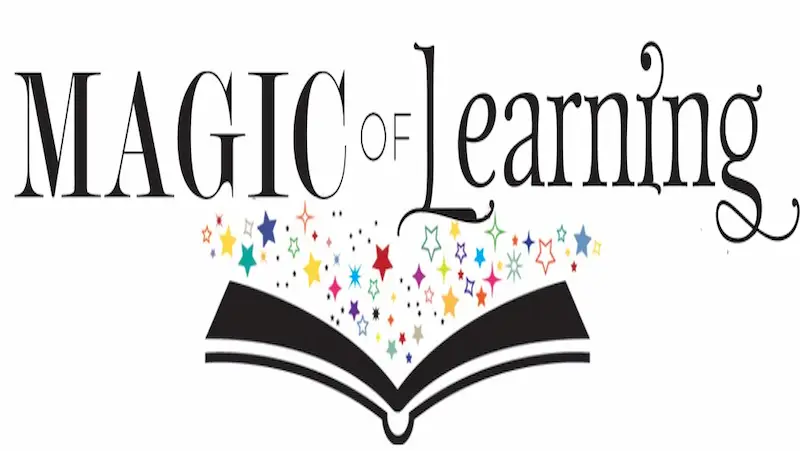
Developing Problem-Solving Abilities
Picture this: A magician faces a room full of eager spectators, each one anticipating the next astonishing trick. Behind the scenes, the magician meticulously plans and executes each illusion, solving a series of complex puzzles to create a seamless performance. In the same way, practicing magic nurtures your problem-solving abilities.
Magic tricks often involve intricate steps, misdirection, and an understanding of human psychology. As you delve into the world of magic, you’re challenged to think critically about the mechanics of each trick. How can you manipulate your audience’s attention? What sequence of actions will lead to the desired outcome? These questions encourage your brain to approach problems from multiple angles, enhancing your analytical skills and fostering a creative approach to finding solutions.
Improving Critical Thinking
At the heart of every magic trick lies the art hub for kids of misdirection. Magicians master the skill of diverting attention away from the real action, making you focus on one thing while they execute another. This technique not only amazes but also demonstrates the power of critical thinking.
When practicing magic, you’re encouraged to scrutinize each move, considering the implications and potential reactions. This process hones your ability to analyze situations, identify patterns, and make logical deductions. Your brain becomes adept at separating relevant information from distractions, a skill that transcends the realm of magic and becomes a valuable asset in daily life.
Developing Confidence and Self-Expression

Overcoming Stage Fright: Embracing the Spotlight
Raise your hand if just the thought of standing in front of a crowd makes your heart race! You’re not alone. Overcoming stage fright is a hurdle many of us face. The key is to start small and build your way up. Whether it’s speaking at a gathering of friends or joining a local club, taking gradual steps helps desensitize those jitters.
Expressing Creativity: Painting Your Unique Canvas
Creativity is a wonderful way to express yourself. From art for kids and music to writing and dance, there’s a world of possibilities waiting for you to explore. The beauty of creativity lies in its freedom – there are no right or wrong answers. Don’t worry about judgments; let your imagination run wild. Whether it’s a simple doodle or a heartfelt poem, each creation is a reflection of your inner world. So, grab that paintbrush, tap those keys, or move to the rhythm – let your creativity flow!
Building Self-Assurance: Your Path to Inner Strength
Confidence isn’t about being the loudest voice in the room; it’s about embracing who you are. Building self-assurance takes time and effort, but the results are incredibly rewarding. Start by recognizing your strengths and achievements. Celebrate even the small wins – they add up! Practice positive affirmations for kids self-talk and challenge those self-doubts that hold you back. Surround yourself with supportive people who uplift you.
Fostering Social Skills and Teamwork
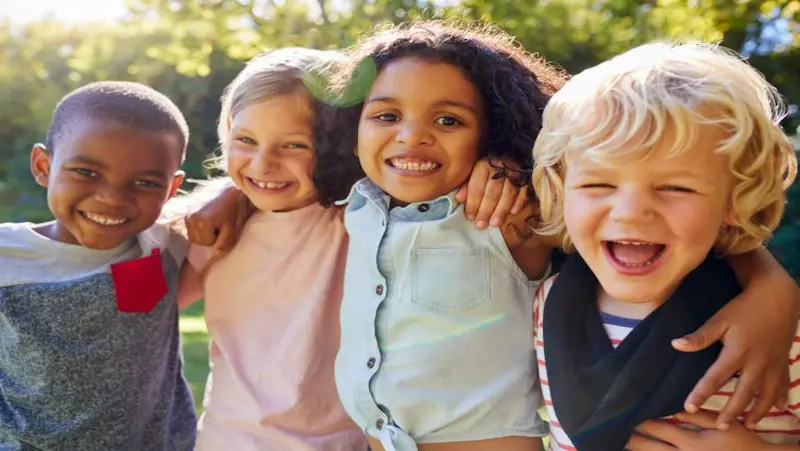
Collaboration in Magic Tricks:
Imagine trying to pull off a jaw-dropping magic trick all by yourself. It’s not impossible, but it becomes so much more captivating when shared with a partner or a group. Collaborative magic tricks require a seamless blend of skills, timing, and trust. Just like in real-life situations, working together on magic tricks teaches us how to coordinate our efforts, respect each other’s strengths, and acknowledge our weaknesses.
Effective Communication:
Have you ever seen a magician reveal their secrets? It’s like uncovering layers of a story, one step at a time. Similarly, effective communication is about articulating thoughts clearly, step by step, to convey ideas or instructions. In magic, precise communication between performers is essential for flawless execution. The same principle applies in our daily lives.
Empathy and Respect:
Now, let’s talk about the magic of empathy. To truly engage an audience, magicians must anticipate their reactions and emotions. This involves stepping into the audience’s shoes and understanding their perspective. Similarly, practicing empathy – the ability to understand and share another person’s feelings – is crucial in building strong relationships.
Choosing the Right Magic Class
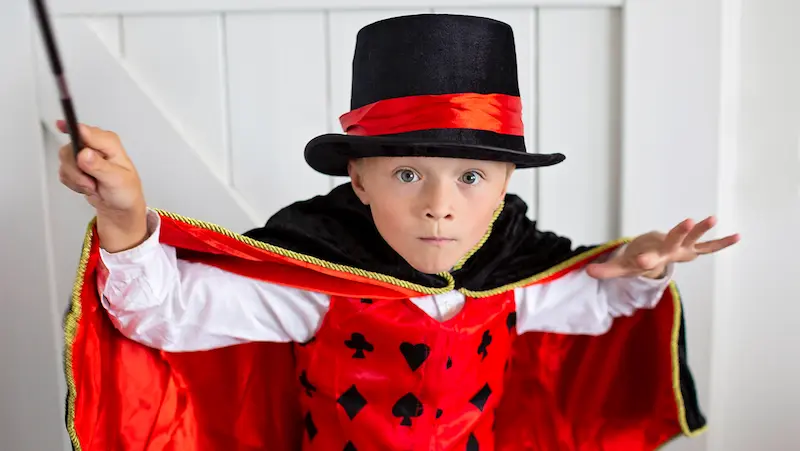
Sleight of Hand: The Art of Deception
Sleight of Hand is the foundation upon which many magical feats are built. It’s the art of skillful manipulation that dazzles the eye and baffles the mind. Magicians who specialize in sleight of hand crafts for kids their tricks with meticulous precision, using deft finger movements to manipulate objects imperceptibly.
Cards appear and disappear, coins transpose, and objects seemingly materialize out of thin air. The true essence of sleight of hand lies in the magician’s ability to manipulate your attention, making you see what they want you to see while they perform their invisible maneuvers.
Illusions and Escapes: Defying the Laws of Reality
Prepare to be transported to the realm of illusion, where the boundaries of reality blur and logic take a backseat. Illusionists create grand spectacles that challenge our perceptions of space and time. From making people levitate to sawing someone in half and then miraculously restoring them, these magicians craft elaborate setups that defy the laws of nature.
Escapology, a captivating subgenre, showcases performers wriggling out of seemingly inescapable situations. The allure of illusions and escapes lies in the sheer audacity of pushing the boundaries of what we believe to be possible.
Mentalism and Mind Reading: The Power of the Mind
Prepare to be mystified by the enigmatic art of mentalism and mind reading for kids. Mentalists appear to possess uncanny abilities to peer into our thoughts, reveal our deepest secrets, and predict our choices. While they may not actually have supernatural powers, they are masters of psychology and perception.
By observing subtle cues in body language, voice tone, and facial expressions, mentalists astutely deduce information that seems beyond ordinary comprehension. Their performances blur the lines between reality and illusion, leaving us pondering the hidden depths of the human mind.
Age-Appropriate Magic Programs
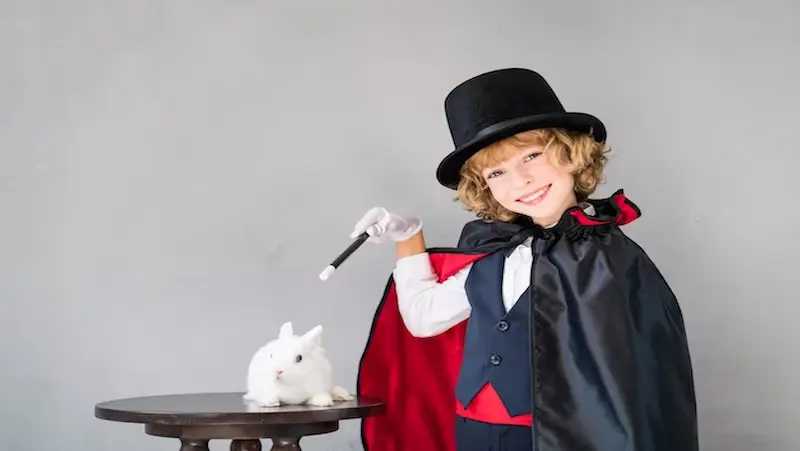
Magic Classes for Young Children (Ages 4-7)
Picture this: your child waving a tiny wand with the most innocent, gleeful smile as colorful scarves dance through the air. Magic classes for our youngest enchanters are all about nurturing their curiosity and motor skills.
These classes often involve interactive tricks, storytelling, and simple illusions that are as delightful to perform as they are to witness. It’s the perfect blend of learning and play, and who knows, you might just have a mini magician pulling coins from behind your ears during dinner!
Intermediate Magic Classes (Ages 8-12)
Ah, the age of curiosity and the quest for mastery! In these classes, the tricks get a bit more intricate, and the young magicians start understanding the mechanics behind the illusions. Card tricks, rope manipulations, and even a touch of sleight of hand come into play.
Beyond the tricks themselves, intermediate magic programs encourage public speaking, showmanship, and the importance of practice. These skills are like ingredients in a magical cauldron that brews confidence and charisma.
Advanced Magic Programs (Ages 13 and above)
As our young apprentices come of age, their journey into the realm of magic takes on a more sophisticated hue. Advanced magic programs delve into the psychology of illusion, misdirection, and the art of creating a mesmerizing performance.
From mind-bending mentalism to elaborate stage tricks, teenagers get to explore their unique magical style. These classes often touch on the history of magic and the great magicians who’ve shaped the art. It’s not just about performing tricks anymore; it’s about creating an unforgettable experience for the audience.
The Magic Class Experience
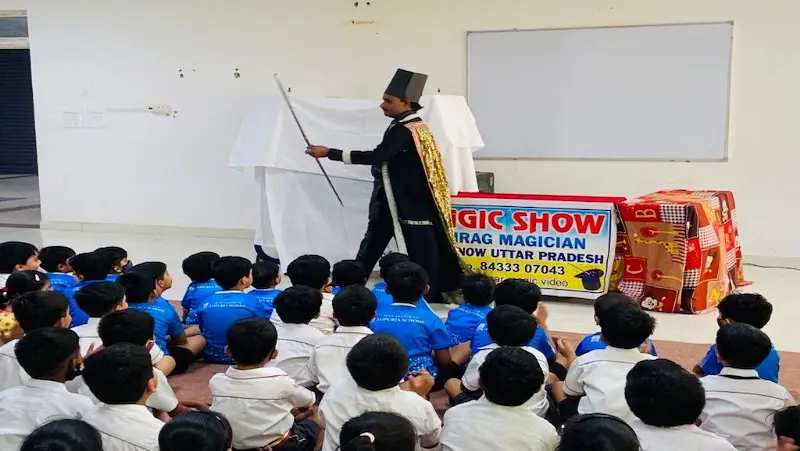
Introduction to Basic Magic Tricks: Laying the Foundation
Every magic adventure begins with the basics. In this enchanting phase, we’ll explore the fundamental tricks that serve as the building blocks of all magical prowess.
From classic card tricks to intriguing coin illusions, we’ll unravel the secrets behind these tricks while also delving into the psychology that makes them work. Remember, even the grandest illusions have humble beginnings, and here’s where your magical journey takes its first exciting step.
Intermediate Skill Development: Unveiling the Intricacies
Once you’ve got the hang of the basics, it’s time to level up your magical finesse. In this phase, we’ll embark on a journey of intricate skill development. You’ll learn how to manipulate objects with finesse, handle misdirection like a true magician, and even invent your tricks that defy explanation.
Along the way, you’ll be challenged to push your limits and refine your techniques, transforming you from a novice into a proficient conjurer of wonders.
Showmanship and Performance Techniques: The Art of Spellbinding
Ah, the stage is set, the audience is waiting, and it’s your time to shine! In this final act of our magical curriculum, we’ll focus on showmanship and performance techniques. After all, a magician isn’t just about tricks; it’s about weaving a captivating narrative, engaging your audience, and leaving them utterly mesmerized.
From understanding the nuances of pacing to perfecting your dramatic flair, this phase will empower you to step onto the stage with confidence and charisma, creating an unforgettable experience for all who are fortunate enough to witness your magic.
Learning Magic Props and Equipment
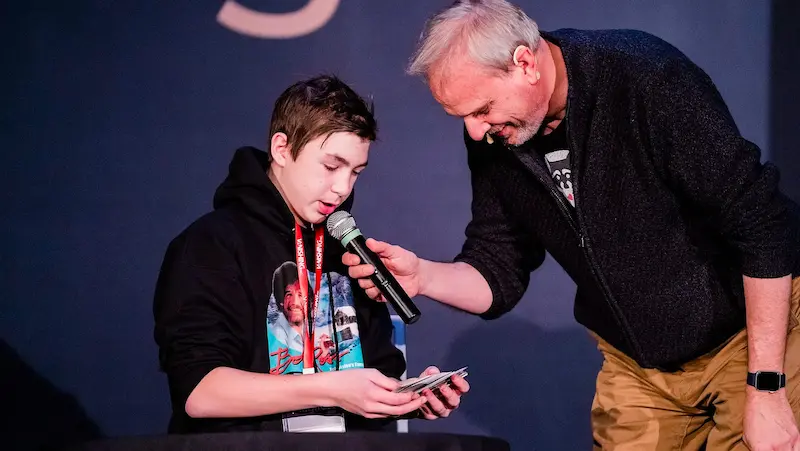
Essential Props for Beginners
Every magician’s journey begins with a set of fundamental props that serve as building blocks for your tricks. These simple yet effective tools lay the foundation for your magical repertoire. Here are a few must-have props for beginners:
1. Playing Cards: A deck of cards is a magician’s best friend. Start with basic card tricks to hone your sleight of hand and misdirection skills.
2. Coins: Coins are versatile props that can be used for a variety of tricks. Mastering coin manipulation will give you a strong foundation in close-up magic.
3. Silk Handkerchiefs: Colorful silk handkerchiefs can be used for vanishing acts, color changes, and more. They add a touch of elegance to your tricks.
4. Rope: With a simple piece of rope, you can perform a range of tricks, from cut-and-restored routines to linking and unlinking effects.
Specialized Props for Advanced Techniques
Once you’ve gained confidence and skill, you might want to explore more specialized props that allow for intricate and baffling tricks. These props require dedicated practice to wield their magic effectively:
1. Floating Devices: Achieve the illusion of objects floating in mid-air. Mastering levitation requires finesse and precise control.
2. Sponge Balls: These soft, squishy balls are perfect for close-up magic. They can vanish, appear, multiply, and even travel between your hands.
3. Shells and Gaffed Coins: Gaffed coins, like expanded shells, flipper coins, and double-sided coins, enable mind-bending transformations and transpositions.
4. Linking Rings: These metal rings seem to magically link and unlink, creating mesmerizing visual effects that captivate audiences.
Safe Handling and Maintenance
Caring for your magic props is essential for their longevity and your performance’s success. Here are a few tips to ensure your props remain in pristine condition:
1. Practice Area: Designate a clean and organized space for practicing. This helps prevent damage to your props and reduces the chance of accidents.
2. Clean Hands: Before handling props, wash and dry your hands. Clean props not only look better but also function smoothly.
3. Storage: Keep your props in dedicated storage containers to prevent them from getting lost, damaged, or tangled.
4. Regular Inspection: Routinely inspect your props for wear and tear. Replace any worn-out items to ensure your tricks are flawless.
Conclusion
In the enchanting world of learning, our magic classes for kids weave wonder into education. Through the captivating art of magic, children grasp leadership skills for kids while wearing the cloak of joy. As they master tricks, they unravel the secrets of both the magical realm and their own potential.
These classes don’t just teach magic; they nurture confidence, dexterity, and creativity. Let your child embark on a journey where learning games for kids becomes a spellbinding adventure, crafting a future where every challenge is met with a touch of magic.
To get your hands on more educational and free resources on coding for kids, robotics for kids, financial education for kids, etc., do check out the BrightCHAMPS Page now!
Also, BrightChamps provides a comprehensive platform for learning about money for kids, offering interactive and engaging resources that teach financial literacy, budgeting, saving, and other essential money management skills.
Frequently Asked Questions
A1. Magic classes offer more than just tricks – they boost creativity, improve dexterity, and enhance critical thinking. Kids also develop public speaking skills and gain a sense of accomplishment.
A2. Magic involves planning, sequencing, and problem-solving. Learning tricks stimulates memory, sharpens attention to detail, and encourages logical thinking, all of which enhance cognitive abilities.
A3. Magic classes are usually suitable for kids aged 7 and up. Younger children might find it a bit challenging to grasp certain concepts.
A4. Kids’ magic classes often cover basic sleight of hand, card tricks, coin tricks, and simple illusions to introduce them to various styles and techniques.
A5. Through performing magic, children overcome stage fright and develop confidence in front of an audience. They also learn to express themselves creatively and effectively.
A6. Yes, definitely. Magic classes provide a safe and supportive environment for kids to gradually overcome their stage fright by performing tricks and gradually building confidence.
A7. Magic classes teach children valuable life skills like communication, patience, and perseverance. They also learn about presentation, showmanship, and the history of magic.
A8. The time it takes to become proficient varies, but with regular practice and dedication, kids can start performing basic tricks confidently within a few months.

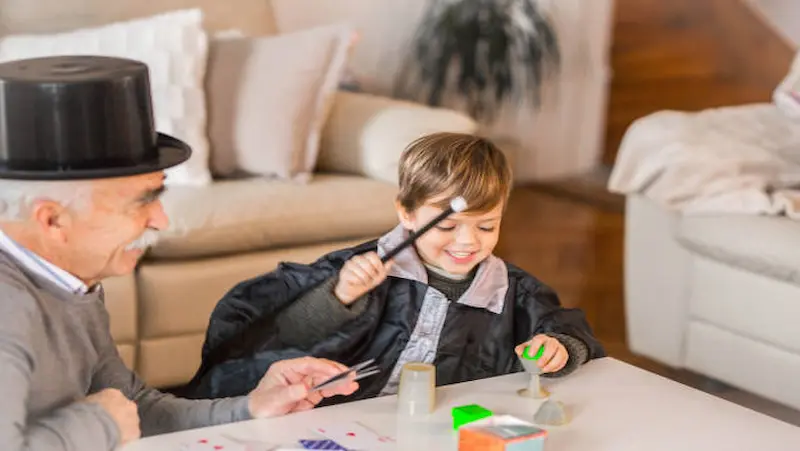
 We are an army of educators and passionate learners from BrightChamps family, committed to providing free learning resources to kids, parents & students.
We are an army of educators and passionate learners from BrightChamps family, committed to providing free learning resources to kids, parents & students.













